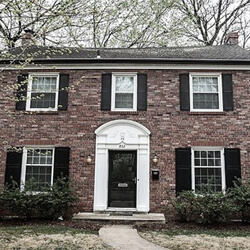Fiction:
Sylvie was in love with her adopted home of Seattle – with the moody, gray skies, the rain, the emerald green landscape. She loved the hum of the city, the coffee shops on every corner, the ferries she rode across Puget Sound. But most of all, she loved her house, a 1928 brick Tudor that she and her husband David bought 15 years earlier, shortly after they were married. The place captured her heart the moment she saw it, with its high, coved ceilings, wood-burning fireplace and gleaming oak floors trimmed in mahogany. Its garden, fragrant with roses, mock orange and lilac. And neighbors, so warm and welcoming.
So, when David came home early one January evening and asked what she thought about moving halfway across the country, to St. Louis, she was certain he’d lost his mind. Images of graffiti, blocks of abandoned buildings and urban decay leapt to mind.
They had good jobs in Seattle. Their daughter Natalie, then 9, walked two blocks to a wonderful school. They had friends in the city. Family. And this lovely house. What was David thinking?
Sure, he acknowledged, things were good. But wouldn’t an adventure be swell? He told Sylvie about the work he was offered at a thriving newspaper in the heart of the city. The opportunity to shape the coverage, nurture budding writers, make an impact. It would be a new challenge, a new place to explore, the kind of opportunity that wouldn’t come their way again. It didn’t have to be forever, he said, a couple of years. They could keep the house in Seattle, find a renter, and return when the time was right.
So Sylvie agreed to consider it. She went to visit. Once in January, then again the following month. David could hardly contain his excitement. He even got Natalie on board. So finally, on Easter Sunday, after touring more than 50 homes (none of which, in Sylvie’s opinion, held a candle to their place in Seattle) she and David made an offer on a house in Webster Groves, just outside St. Louis. It was a brick Colonial, built in 1932, in a neighborhood with sprawling green lawns and rows of old Maple trees lining the streets. They made the move when Natalie’s classes ended in June.
The Webster Groves house had fallen on hard times; a contractor bought it cheap, made the necessary repairs and flipped it. There were some rough edges, so Sylvie and David hired a local Bosnian man, Amir Petrovic, who had built houses in his native country before he and his family fled the war. Amir was a master craftsman, meticulous in his work. He spoke virtually no English, so he and Sylvie resorted to pointing and nodding. Amir would fix Sylvie’s eyes with his, raise his shaggy brow, then lift his hand toward the offending issue, uttering the two English words he seemed to have mastered: BEEEEEG PROBLEM!
Over the next month, Amir turned up alone at the crack of dawn each day, and worked late into the afternoon, smoothing the rough edges from the house, shaking his head in disgust with each new problem he discovered.
Meanwhile, with the din of Amir’s tools in the background, Sylvie and Natalie spent hot summer afternoons curled up on the screened-in porch, laughing and talking, eating chocolate ice cream or sipping lemonade. And as summer slowly drew to a close, it dawned on Sylvie that those lazy afternoons she would forever treasure had nothing to do with any particular house or city. They would have been just as glorious had they unfolded anywhere in the world.
Lynn Steinberg has worked as a high-school teacher, journalist and communications executive over the course of a long and varied career. After years of city life up and down the West Coast, she recently retired from The Boeing Company and moved to Manzanita full-time with her husband Ellis.


